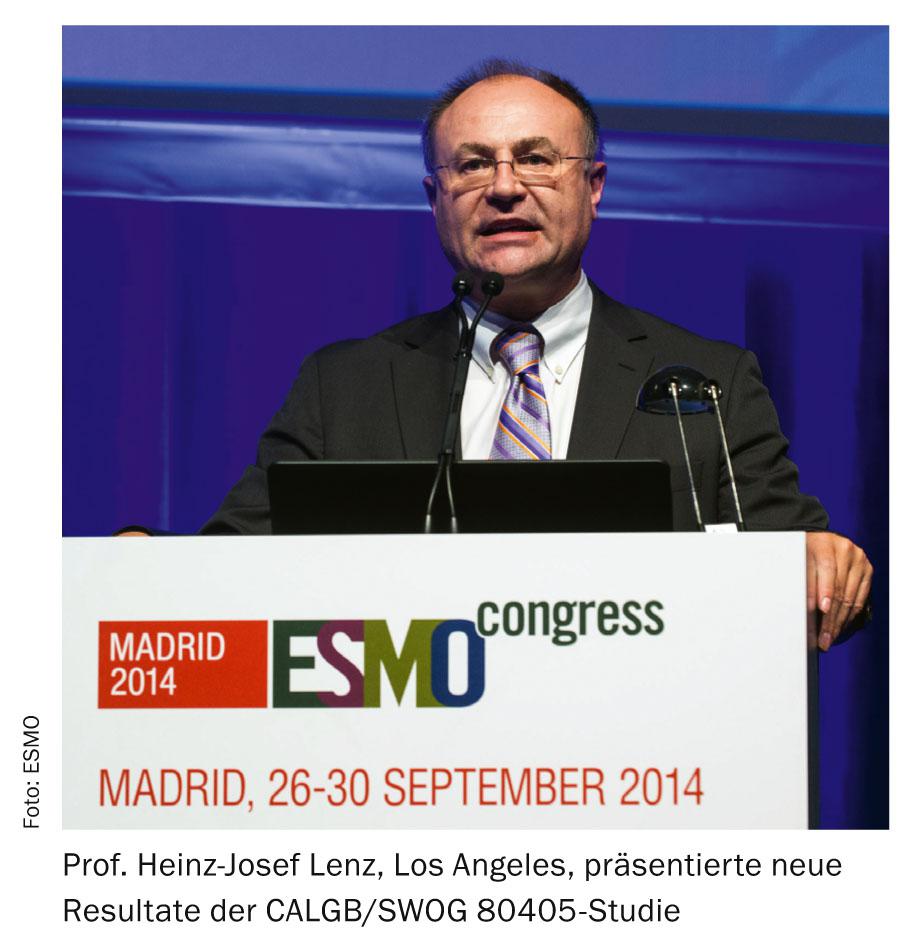At this year’s ESMO Congress in Madrid, treatment options for metastatic colorectal cancer were also discussed. Is there an optimal strategy for patients with a wild-type RAS mutation, and would it be anti-EGFR or anti-VEGF treatment?
(ee) Prof. Heinz-Josef Lenz, University of Southern California Norris Comprehensive Cancer Center, Los Angeles, USA, presented the latest results of the CALGB/SWOG 80405 study [1]. This study evaluated a regimen of irinotecan/5-FU/leucovorin (FOLFIRI) or oxaliplatin/5-FU/leucovorin (mFOLFOX6) in combination with bevacizumab (BEV) or cetuximab (CET) as first-line therapy. Chemotherapy was determined by the oncologist, and then patients were randomized to the BEV or CET group. Patients with wild-type RAS were included in the study. The primary endpoint was overall survival (OS). 1137 patients were included; 26.6% were treated with FOLFIRI, 73.4% with mFOLFOX6.

Both therapy regimes equivalent
Earlier this year, the researchers had presented results concluding that both treatment regimens – in patients with previously untreated metastatic colorectal cancer and KRAS wild-type – were equivalent in terms of OS. The presentation at the ESMO Congress focused on whether complementary RAS testing can identify subgroups of patients who benefit more from one therapeutic regimen or another. However, no significant differences in OS and progression-free survival (PFS) were apparent between the CET and BEV groups. However, the CET arm showed a stronger treatment response than the BEV arm (68.6% vs 53.6%).
The speaker pointed out that this study is a “work in progress”: it is possible that further analyses will nevertheless reveal differences in the two treatment regimens. In addition, many questions remain unanswered, for example with regard to therapy duration, dose intensity, or certain subgroups (such as patients with relapse). The fact that the median OS could be increased to over 30 months also sets a new benchmark.
New results from the FIRE-3 study
Sebastian Stintzing, MD, of the University of Munich, Germany, presented new results from the FIRE-3 study, which was conducted at 150 centers in Germany and Austria. Patients, all with metastatic colorectal cancer and KRAS wild-type (exon 2), were treated with FOLFIRI and randomized to a CET or BEV regimen. To assess tumor response according to RECIST 1.1 criteria, radiological analyses were performed by independent experts [2]. Early tumor shrinkage (ETS, reduction of tumor diameter by more than 20% within six weeks) and increased depth of response (DpR, maximum tumor reduction at any time point compared to baseline) were assessed.
The FOLFIRI plus CET treatment regimen induced a higher response rate (ORR), a greater ETS rate, and a greater DpR compared with the FOLFIRI plus BEV regimen. These outcomes may partially explain why a significant OS benefit was shown in the FOLFIRI/CET group: 33.1 vs. 25.0 months (HR 0.697, p=0.0059). The proportion of patients achieving ETS was significantly greater in the CET group than in the BEV group (67.5 vs. 47.9%, p=0.0013); in both treatment groups, achieving ETS was significantly associated with better PFS. The ORR was 66.5% in the CET arm and 55.6% in the BEV arm (p = 0.016). Median DpR was significantly greater in the CET arm (48.2 vs. 33.0%) and correlated with survival.
Dr. Stintzing summarized the results: Median OS was significantly higher in all patients with wild-type RAS who received cetuximab as a first-line therapy. Radiological analyses also showed a significantly higher ORR, higher rate of ETS, and greater DpR in the FOLFIRI/CET group.
Why such different results?
In the subsequent discussion, experts Prof. Andres Cervantes, University of Valencia, Spain, Prof. Alberto Sobrero, Ospedale San Martino, Genoa, Italy, and Prof. Fortunato Ciardiello, Seconda Università di Napoli, Naples, Italy, assessed the study results. Both therapeutic regimens are potential options for initiating treatment in patients with metastatic colorectal cancer and RAS wild-type. The higher response rate in the treatment regimen with CET might influence the choice of initial therapy. However, the data from the CALGB/SWOG 80405 study need to be examined in more depth, especially with respect to ETS and DpR. It is important to inform patients accordingly when making treatment decisions. Tolerability and side effects are also significant aspects when discussing with the patient.
Prof. Ciardiello pointed out that metastatic colorectal cancers are heterogeneous diseases. Testing for KRAS and NRAS are only initial steps in identifying patients who can optimally benefit from available treatment options. All patients with metastatic colorectal cancer should undergo RAS testing before first-line treatment.
References:
- Lenz HJ, et al: CALGB/SWOG 80405: PHASE III trial of irinotecan/5-FU/leucovorin (FOLFIRI) or oxaliplatin/5-FU/leucovorin (mFOLFOX6) with bevacizumab (BV) or cetuximab (CET) for patients (pts) with expanded ras analyses untreated metastatic adenocarcinoma of the colon or rectum (MCRC); Abstract 501O.
- Stintzing S, et al: Independent radiological evaluation of objective response rate, early tumor shrinkage, and depth of response in FIRE-3 (AIO KRK-0306) in the final RAS evaluable population; Abstract LBA11.
Source: European Society for Medical Oncology (ESMO) Congress, September 26-30, 2014, Madrid.
InFo ONCOLOGY & HEMATOLOGY 2014; 2(9): 24-26.











